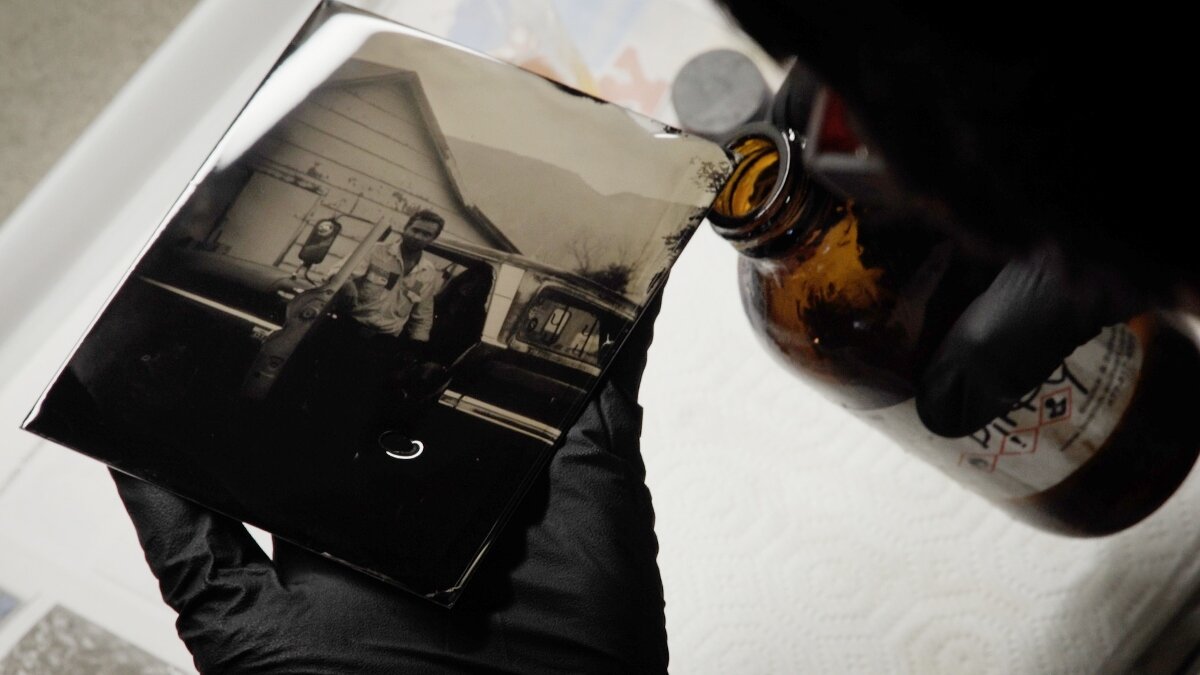‘Don’t move': A Fruita photographer keeps an antique tradition alive

FRUITA, Colo. — “Ok, don’t move!” commands tintype photographer Vanessa Ford.
You can obey her command or not, but if you don’t, your photo will end up like one of Bigfoot: blurry.
Why the blur? Because Ford captures her photographs with 170-year-old technology: a wood, leather, and brass camera. An exposure for this antique method can take anywhere between four to 12 seconds. If you don’t hold still, the chemicals will record your movement, and you’ll be a blur.
“The first time I saw a picture develop in the darkroom, I was amazed. And then the first tintype I ever saw come out in the fixer, it was the same thing,” recalled Ford.
What will the weather be?
Ford had the weather figured out the night before she traveled to Palisade, Colorado to photograph a young couple and their truck. But, as is typical with Colorado, the weather can be unpredictable. She arrived to find overcast skies and drizzles of rain. It’s not the moisture she’s worried about; the hard part is trying to figure out how much UV is present even through the cloud cover.
The chemicals in the wet-plate process respond to ultraviolet light. Ford uses her smartphone (just like they did in the 1860s) to see the UV index, though it’s hardly an exact science. Nevertheless, it helps her to decide what aperture to use and how long she’ll expose the plate to the light. If she doesn’t get it right, she’ll just do it again until she does.
Ford composes the shot of the couple and their old truck. The “screen” of this old camera is a piece of glass that resembles a frosted drinking glass. That texture catches the light coming in through the lens and becomes an upside-down image of whatever the camera is pointed at.
With the young couple in position, Ford covers her head with a light-blocking cloth — an old towel — so she can see the image clearly. She holds a magnifying loupe up to the glass to see if the camera is in focus.
“Ok, stay there and don’t move,” Ford tells the couple.

Ford now inserts the prepared tin plate between the ground glass and the lens in a light-tight plate holder. Then she pulls out the dark slide and the camera is ready to take a picture. Ford gently removes the old lens cap. There is no shutter, no click. Removing the cap is how light is let into the camera.
“One Mississippi, two Mississippi, three Mississippi, four Mississippi,” says Ford under her breath.
She then carefully replaces the lens cap and says, “ Now you can move!”
Ford replaces the dark slide and runs to her homemade traveling “darkbox.” With her hands shoved through light tight sleeves, she washes the tin plate with chemicals that will fix it into a permanent image. Now it is safe to be brought into the light. Out in the open where all can see, Ford slides the tintype into a tray full of a developing chemical. In a few seconds, the image comes to life. A current moment is preserved in a way that appears 150 years old.
“With digital, you always know what you’re gonna get,” Ford said. “With tintype, you never know what you’re gonna get, and that’s the magic.”
Back in Fruita where Ford lives, she coats the fully dried tintype in a high-quality varnish. Wet-plate photography uses actual silver. Without a coating of varnish, the silver parts of the image will tarnish just like silverware. Once the varnish is fully dry, Ford delivers the tintype to her clients.
Ford’s favorite photo, by far, is one she took of her wife, Megan Dunegan. She said she loves it because Dunegan is her biggest champion and best friend, and also because she thinks it is her best work. In the photo, Dunegan is holding one of their egg-producing chickens.

When Ford said, “Hold still,” Dunegan followed instructions. The chicken, however, did not and shook her feathered head. The chicken's body is in focus, but her head is an indistinguishable blur.
Like Ford said, “you never know what you’re gonna get.”
Cullen Purser is a multimedia journalist at Rocky Mountain PBS. You can reach him at cullenpurser@rmpbs.org.
Related Story
Digital killed the magic
“I was working in photo labs when digital [photography] first started. I avoided going to digital for as long as I could but then I was able to get jobs doing sport photography and I made money that way,” Ford said. “So, I did go to digital but it really just kind of killed the magic.”
About two decades later, something changed.
“I woke up one day and I was like, I want to do wet-plate photography,” Ford said. “I always have my best ideas in the morning, you know, my morning epiphanies. So, I was like, that’s got to be a good idea!”
Wet-plate is the process of making tintype photos. The plates that eventually become photos must be kept wet with chemicals while the picture is taken. A plate can be a piece of glass or, in the case of tintypes, a thin piece of metal.
To learn the basics, Ford attended a course on wet-plate photography at Bostick and Sullivan in Santa Fe, New Mexico. The rest of her learning has come the hard way: by just doing it again and again and again. Only through real-life practice can she gain a sense of how different circumstances will affect the process.
“With this process, there’s so many different variables that come into play, that if you’re expecting perfect, you might have to change your definition of what perfect is,” Ford said.


